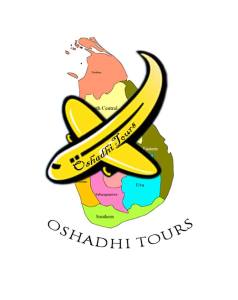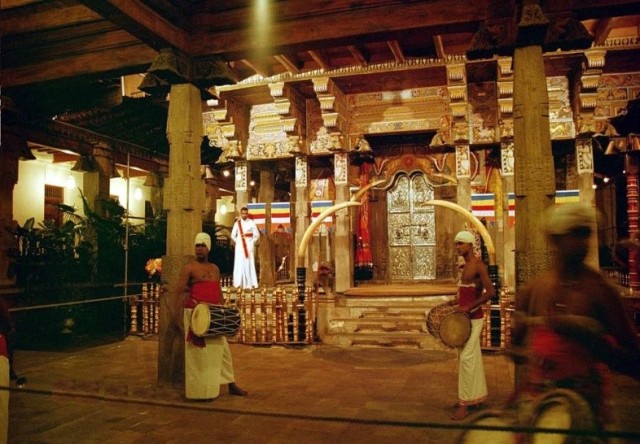Pinnawala Elephant orphanage (link to source data)
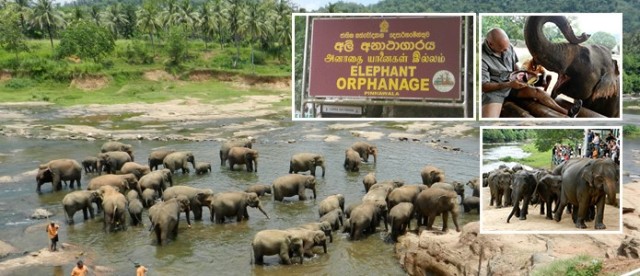 Pinnawala Elephant Orphanage is an orphanage, nursery and captive breeding ground for wild Asian elephants located at Pinnawala village, 13 km (8.1 mi) northwest of Kegalle town in Sabaragamuwa Province of Sri Lanka. Pinnawala is notable for having the largest herd of captive elephants in the world. In 2011, there were 88 elephants, including 37 males and 51 females from 3 generations, living in Pinnawala.
Pinnawala Elephant Orphanage is an orphanage, nursery and captive breeding ground for wild Asian elephants located at Pinnawala village, 13 km (8.1 mi) northwest of Kegalle town in Sabaragamuwa Province of Sri Lanka. Pinnawala is notable for having the largest herd of captive elephants in the world. In 2011, there were 88 elephants, including 37 males and 51 females from 3 generations, living in Pinnawala.
The orphanage was originally founded in order to afford care and protection to many of the orphaned unweaned wild elephants found wandering in and near the forests of Sri Lanka. It was established in 1975 by the Sri Lanka Department of Wildlife Conservation (DWC).
Anuradhapura – archaeological site (link to source data)
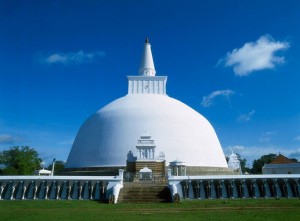 The Ruwanwelisaya is a stupa in Sri Lanka, considered a marvel for its architectural qualities and sacred to many Buddhists all over the world. It was built by King Dutugemunu c. 140 B.C., who became lord of all Sri Lanka after a war in which the Chola King Elara, was defeated. It is also known as Mahathupa, Swarnamali Chaitya, Suvarnamali Mahaceti (in Pali) and Rathnamali Dagaba.
The Ruwanwelisaya is a stupa in Sri Lanka, considered a marvel for its architectural qualities and sacred to many Buddhists all over the world. It was built by King Dutugemunu c. 140 B.C., who became lord of all Sri Lanka after a war in which the Chola King Elara, was defeated. It is also known as Mahathupa, Swarnamali Chaitya, Suvarnamali Mahaceti (in Pali) and Rathnamali Dagaba.
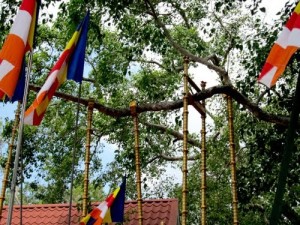 This is one of the Solosmasthana (the 16 places of veneration) and the Atamasthana (the 8 places of veneration in the ancient sacred city of Anuradhapura). The stupa is one of the world’s tallest monuments, standing at 338 feet (103 m) and with a circumference of 950 ft (290 m).
This is one of the Solosmasthana (the 16 places of veneration) and the Atamasthana (the 8 places of veneration in the ancient sacred city of Anuradhapura). The stupa is one of the world’s tallest monuments, standing at 338 feet (103 m) and with a circumference of 950 ft (290 m).
Jaya Sri Maha Bodhi is a Sacred Fig tree in Anuradhapura, Sri Lanka. It is said to be the southern branch from the historical Bodhi tree Sri Maha Bodhi at Bodh Gaya in India under which Lord Buddha attained Enlightenment. It was planted in 288 BC, and is the oldest living human-planted tree in the world with a known planting date. Today it is one of the most sacred relics of the Buddhists in Sri Lanka and respected by Buddhists all over the world.
Yapahuwa – archaeological site (link to source data)
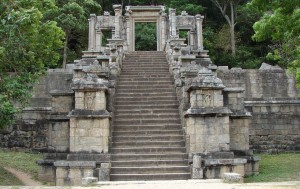 Yapahuwa served as the capital of Sri Lanka in the latter part of the 13th century (1273–1284). Built on a huge, 90 meter high rock boulder in the style of the Sigiriya rock fortress, Yapahuwa was a palace and military stronghold against foreign invaders.
Yapahuwa served as the capital of Sri Lanka in the latter part of the 13th century (1273–1284). Built on a huge, 90 meter high rock boulder in the style of the Sigiriya rock fortress, Yapahuwa was a palace and military stronghold against foreign invaders.
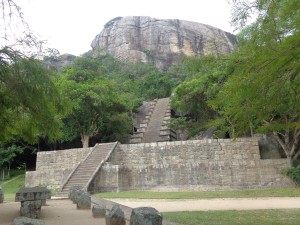 The palace and fortress were built by King Buvanekabahu I (1272–1284) in the year 1273. Many traces of ancient battle defences can still be seen, while an ornamental stairway, is its biggest showpiece. On top of the rock are the remains of a stupa, a Bodhi tree enclosure, and a rock shelter/cave used by Buddhist monks, indicating that earlier this site was used as a Buddhist monastery, like many boulders and hills in the area. There are several caves at the base of the rock. In one of them there is a shrine with Buddha images. One cave has a Brahmi script inscription. At the southern base of the rock there is a fortification with two moats and ramparts. In this enclosure there are the remains of a number of buildings including a Buddhist shrine. There is also a Buddhist temple called Yapawwa Rajamaha Vihara built during the Kandyan period.
The palace and fortress were built by King Buvanekabahu I (1272–1284) in the year 1273. Many traces of ancient battle defences can still be seen, while an ornamental stairway, is its biggest showpiece. On top of the rock are the remains of a stupa, a Bodhi tree enclosure, and a rock shelter/cave used by Buddhist monks, indicating that earlier this site was used as a Buddhist monastery, like many boulders and hills in the area. There are several caves at the base of the rock. In one of them there is a shrine with Buddha images. One cave has a Brahmi script inscription. At the southern base of the rock there is a fortification with two moats and ramparts. In this enclosure there are the remains of a number of buildings including a Buddhist shrine. There is also a Buddhist temple called Yapawwa Rajamaha Vihara built during the Kandyan period.
The Tooth Relic was brought from Dambadeniya and kept in the Tooth Temple built for the purpose at the top of the third staircase. The relics were carried away from the temple here to South India by the Pandyas, and then recovered in 1288 by Parakkramabahu III (1287–1293), who temporarily placed them in safety at Polonnaruwa.
Yapahuwa was one of the ephemeral capitals of medieval Sri Lanka. The citadel of Yapahuwa lying midway between Anuradhapura and Kurunegala was built around a huge granite rock rising abruptly almost a hundred meters above the surrounding lowlands.
In 1272, King Bhuvenakabahu transferred the capital from Polonnaruwa to Yapahuwa in the face of Dravidian invasions from South India, bringing the Sacred Tooth Relic with him. Following the death of King Bhuvenakabahu in 1284, the Pandyans of South India invaded Sri Lanka once again, and succeeded in capturing Sacred Tooth Relic. Following its capture, Yapahuwa was largely abandoned and inhabited by Buddhist monks and religious ascetics.
Polonnaruwa – archaeological site (link to source data)
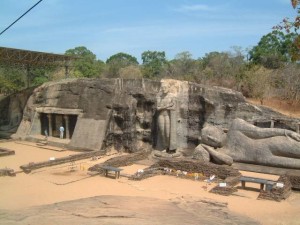 Polonnaruwa is a town. The second most ancient of Sri Lanka‘s kingdoms, Polonnaruwa was first declared the capital city by King Vijayabahu I, who defeated the Chola invaders in 1070 to reunite the country once more under a local leader.
Polonnaruwa is a town. The second most ancient of Sri Lanka‘s kingdoms, Polonnaruwa was first declared the capital city by King Vijayabahu I, who defeated the Chola invaders in 1070 to reunite the country once more under a local leader.
The Ancient City of Polonnaruwa has been declared a World Heritage Site.
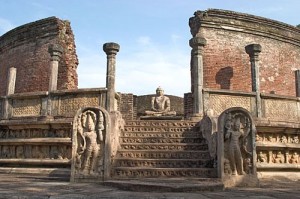 History : While Vijayabahu‘s victory and shifting of kingdoms to the more strategic Polonnaruwa is considered significant, the real “Hero of Polonnaruwa” of the history books is actually Parakramabahu I. It was his reign that is considered the Golden Age of Polonnaruwa. Trade and agriculture flourished under the patronage of the king, who was so adamant that no drop of water falling from the heavens was to be wasted and each was to be used toward the development of the land. Hence, irrigation systems that are far superior to those of the Anuradhapura Age were constructed during Parakramabahu’s reign – systems which to this day supply the water necessary for paddy cultivation during the scorching dry season in the east of the country. The greatest of these systems is the Parakrama Samudra or the Sea of Parakrama. It is of such a width that it is impossible to stand upon one shore and view the other side. It also encircles the main city like a ribbon, being both a moat against intruders and the lifeline of the people in times of peace. The Kingdom of Polonnaruwa was completely self-sufficient during King Parakramabahu’s reign.
History : While Vijayabahu‘s victory and shifting of kingdoms to the more strategic Polonnaruwa is considered significant, the real “Hero of Polonnaruwa” of the history books is actually Parakramabahu I. It was his reign that is considered the Golden Age of Polonnaruwa. Trade and agriculture flourished under the patronage of the king, who was so adamant that no drop of water falling from the heavens was to be wasted and each was to be used toward the development of the land. Hence, irrigation systems that are far superior to those of the Anuradhapura Age were constructed during Parakramabahu’s reign – systems which to this day supply the water necessary for paddy cultivation during the scorching dry season in the east of the country. The greatest of these systems is the Parakrama Samudra or the Sea of Parakrama. It is of such a width that it is impossible to stand upon one shore and view the other side. It also encircles the main city like a ribbon, being both a moat against intruders and the lifeline of the people in times of peace. The Kingdom of Polonnaruwa was completely self-sufficient during King Parakramabahu’s reign.
Trincomalee (link to source data)
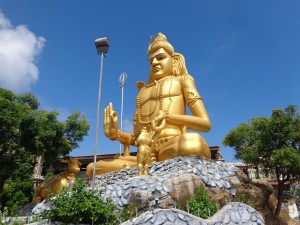 The recorded history of Trincomalee spans more than two and a half thousand years beginning with civilian settlement associated with the Koneswaram temple in the pre-modern era. One of the oldest cities in Asia, it has served as a major maritime seaport in the international trading history of the island with South East Asia. In the ancient world, it was successively the capital of eastern kingdoms of the Vanni country, developing under the Pallava Dynasty, Chola Dynasty, Pandyan Dynasty, the Vannimai chieftaincies and the Jaffna kingdom through the Koneswaram shrine’s revenue. Trincomalee’s urbanization continued when made into a fortified port town following the Portuguese conquest of the Jaffna kingdom, changing hands between the Danish in 1620, the Dutch, the French following a battle of the American Revolutionary War and the British in 1795, being absorbed into the British Ceylon state in 1815.
The recorded history of Trincomalee spans more than two and a half thousand years beginning with civilian settlement associated with the Koneswaram temple in the pre-modern era. One of the oldest cities in Asia, it has served as a major maritime seaport in the international trading history of the island with South East Asia. In the ancient world, it was successively the capital of eastern kingdoms of the Vanni country, developing under the Pallava Dynasty, Chola Dynasty, Pandyan Dynasty, the Vannimai chieftaincies and the Jaffna kingdom through the Koneswaram shrine’s revenue. Trincomalee’s urbanization continued when made into a fortified port town following the Portuguese conquest of the Jaffna kingdom, changing hands between the Danish in 1620, the Dutch, the French following a battle of the American Revolutionary War and the British in 1795, being absorbed into the British Ceylon state in 1815. 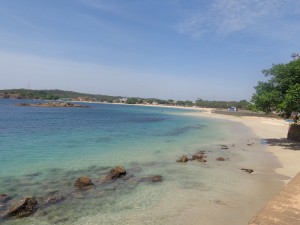 The city’s architecture shows some of the best examples of interaction between native and European styles. Attacked by the Japanese as part of the Indian Ocean raid during World War II in 1942, the city and district were affected after Sri Lanka gained independence in 1948, when the political relationship between Tamil and Sinhalese people deteriorated, erupting into civil war. It is home to major naval and air force bases at the Trincomalee Garrison. The city also has the largest Dutch fort on the island.
The city’s architecture shows some of the best examples of interaction between native and European styles. Attacked by the Japanese as part of the Indian Ocean raid during World War II in 1942, the city and district were affected after Sri Lanka gained independence in 1948, when the political relationship between Tamil and Sinhalese people deteriorated, erupting into civil war. It is home to major naval and air force bases at the Trincomalee Garrison. The city also has the largest Dutch fort on the island.
Dambulla Cave Temple (link to source data)
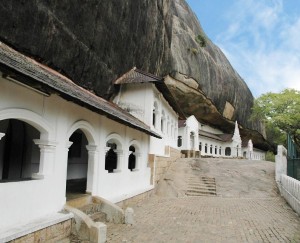 Dambulla cave temple: (Sinhala: dam̆būlū len vihāraya, also known as the Golden Temple of Dambulla is a World Heritage Site (1991) in Sri Lanka, situated in the central part of the country. This site is situated 148 km east of Colombo and 72 km north of Kandy. It is the largest and best-preserved cave temple complex in Sri Lanka. The rock towers 160 m over the surrounding plains.There are more than 80 documented caves in the surrounding area. Major attractions are spread over 5 caves, which contain statues and paintings.
Dambulla cave temple: (Sinhala: dam̆būlū len vihāraya, also known as the Golden Temple of Dambulla is a World Heritage Site (1991) in Sri Lanka, situated in the central part of the country. This site is situated 148 km east of Colombo and 72 km north of Kandy. It is the largest and best-preserved cave temple complex in Sri Lanka. The rock towers 160 m over the surrounding plains.There are more than 80 documented caves in the surrounding area. Major attractions are spread over 5 caves, which contain statues and paintings. 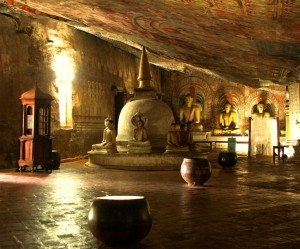 These paintings and statues are related to Lord Buddha and his life. There are a total of 153 Buddha statues, 3 statues of Sri Lankan kings and 4 statues of gods and goddesses. The latter include two statues of Hindu gods, the god Vishnu and the god Ganesh. The murals cover an area of 2,100 square metres. Depictions on the walls of the caves include the temptation by the demon Mara, and Buddha’s first sermon.
These paintings and statues are related to Lord Buddha and his life. There are a total of 153 Buddha statues, 3 statues of Sri Lankan kings and 4 statues of gods and goddesses. The latter include two statues of Hindu gods, the god Vishnu and the god Ganesh. The murals cover an area of 2,100 square metres. Depictions on the walls of the caves include the temptation by the demon Mara, and Buddha’s first sermon.
Sigiriya aka Lion Rock (link to source data)
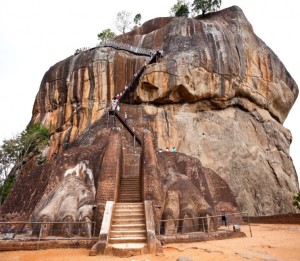 Sigiriya (Lion Rock Sinhala: pronounced see-gee-ree-yah) is an ancient palace located in the central Matale District near the town of Dambulla in the Central Province, Sri Lanka. The name refers to a site of historical and archaeological significance that is dominated by a massive column of rock nearly 200 metres (660 ft) high. According to the ancient Sri Lankan chronicle the Culavamsa, this site was selected by King Kasyapa (477 – 495 CE) for his new capital. He built his palace on the top of this rock and decorated its sides with colourful frescoes. On a small plateau about halfway up the side of this rock he built a gateway in the form of an enormous lion.
Sigiriya (Lion Rock Sinhala: pronounced see-gee-ree-yah) is an ancient palace located in the central Matale District near the town of Dambulla in the Central Province, Sri Lanka. The name refers to a site of historical and archaeological significance that is dominated by a massive column of rock nearly 200 metres (660 ft) high. According to the ancient Sri Lankan chronicle the Culavamsa, this site was selected by King Kasyapa (477 – 495 CE) for his new capital. He built his palace on the top of this rock and decorated its sides with colourful frescoes. On a small plateau about halfway up the side of this rock he built a gateway in the form of an enormous lion. 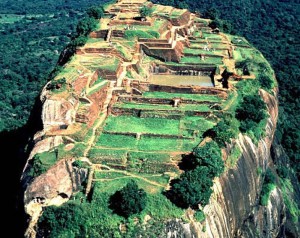 The name of this place is derived from this structure —Sīhāgiri, the Lion Rock. The capital and the royal palace was abandoned after the king’s death. It was used as a Buddhist monastery until the 14th century.
The name of this place is derived from this structure —Sīhāgiri, the Lion Rock. The capital and the royal palace was abandoned after the king’s death. It was used as a Buddhist monastery until the 14th century.
Sigiriya today is a UNESCO listed World Heritage Site. It is one of the best preserved examples of ancient urban planning. It is the most visited historic site in Sri Lanka.
Kandy: Temple of the Tooth Relic (link to source data)
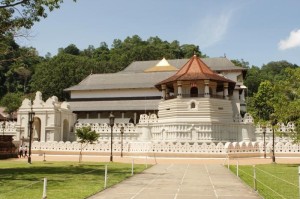 Dalada Maligawa: Temple of the Sacred Tooth Relic is a Buddhist temple in the city of Kandy, Sri Lanka. It is located in the royal palace complex of the former Kingdom of Kandy, which houses the relic of the tooth of Buddha. Since ancient times, the relic has played an important role in local politics because it is believed that whoever holds the relic holds the governance of the country. Kandy was the last capital of the Sri Lankan kings and is a UNESCO world heritage site partly due to the temple.
Dalada Maligawa: Temple of the Sacred Tooth Relic is a Buddhist temple in the city of Kandy, Sri Lanka. It is located in the royal palace complex of the former Kingdom of Kandy, which houses the relic of the tooth of Buddha. Since ancient times, the relic has played an important role in local politics because it is believed that whoever holds the relic holds the governance of the country. Kandy was the last capital of the Sri Lankan kings and is a UNESCO world heritage site partly due to the temple.
**Of note: the information and images contained on this page are from a variety of sources and mostly Wikipedia. Oshadhi Tours have sought to be in line with the Reuse Policy however if there is anything which does not follow this it will be removed once notified. All information and pictures published with link to site wherever possible.
